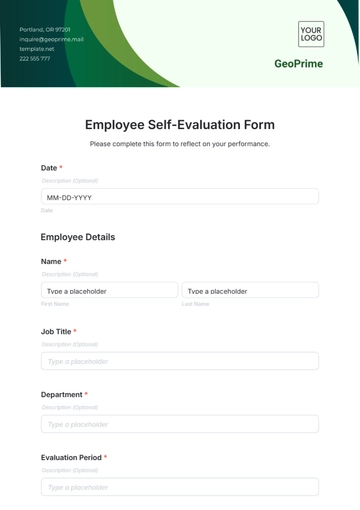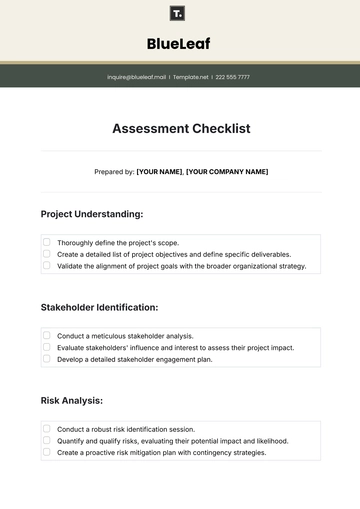Free Environmental Risk Assessment

Date: December 2, 2080
[YOUR COMPANY NAME], [YOUR COMPANY ADDRESS]
I. Introduction
The purpose of this Environmental Risk Assessment (ERA) is to identify, analyze, and evaluate the potential environmental risks associated with operations at [YOUR COMPANY NAME]. The assessment will also propose mitigation strategies to minimize these risks. This risk assessment covers both current operations and future activities planned for the next five years.
II. Methodology
The risk assessment was conducted using a combination of site inspections, interviews with key personnel, and environmental data analysis. The following tools and techniques were used to assess risks:
Risk matrices
Qualitative assessment through expert judgment
Quantitative analysis (environmental impact models)
III. Risk Identification
The following environmental risks were identified at the [YOUR COMPANY NAME]:
Air Pollution: Emissions from machinery and vehicles may contribute to air quality degradation.
Water Contamination: Potential leakage from wastewater treatment facilities could lead to the contamination of nearby water sources.
Waste Disposal: Improper disposal of hazardous and non-hazardous waste could result in soil and groundwater contamination.
Noise Pollution: Operations involving heavy machinery could exceed acceptable noise levels, impacting surrounding communities.
Climate Change: Increased severity of storms and temperature fluctuations affecting plant operations and safety.
Resource Depletion: Overuse of local water resources, which could affect surrounding ecosystems.
IV. Risk Analysis
Each identified risk was analyzed based on its likelihood and potential impact:
Risk | Likelihood | Impact | Risk Level |
|---|---|---|---|
Air Pollution | Likely | High | High |
Water Contamination | Possible | Severe | High |
Waste Disposal | Likely | Moderate | Medium |
Noise Pollution | Unlikely | Low | Low |
Climate Change | Possible | High | High |
Resource Depletion | Likely | Moderate | Medium |
V. Risk Evaluation
Based on the analysis, the following risks are prioritized for mitigation:
Air Pollution – High risk, requires immediate attention.
Water Contamination – High risk, requires implementation of better wastewater management systems.
Climate Change – High-risk, long-term mitigation measures should be explored.
Waste Disposal – Medium risk, regular audits are needed to ensure proper disposal.
Resource Depletion – Medium risk, more efficient water management required.
Noise Pollution – Low risk, periodic monitoring of noise levels.
VI. Mitigation Strategies
The following mitigation strategies are recommended:
Air Pollution: Install air filtration systems on machines and conduct regular air quality monitoring.
Water Contamination: Upgrade wastewater treatment facilities and conduct routine water quality checks.
Waste Disposal: Implement a comprehensive waste management plan, focusing on recycling and safe disposal methods.
Noise Pollution: Maintain machinery to reduce noise and establish buffer zones around noisy areas.
Climate Change: Assess facility resilience to extreme weather conditions and implement energy-efficient technologies.
Resource Depletion: Reduce water consumption through recycling and rainwater harvesting.
VII. Impact Assessment
Each risk, if left unmanaged, could result in significant environmental impacts:
Air Pollution: Can lead to respiratory health problems in local communities and contribute to regional climate change.
Water Contamination: May harm local aquatic ecosystems and disrupt water supply to nearby settlements.
Waste Disposal: Hazardous waste could contaminate soil and groundwater, posing long-term ecological risks.
Noise Pollution: Could disturb local wildlife and community well-being.
Climate Change: Extreme weather events may damage infrastructure and disrupt plant operations.
Resource Depletion: This could lead to the exhaustion of local water supplies, affecting agricultural and drinking water needs.
VIII. Monitoring and Review
To ensure that mitigation strategies are effective, the following actions will be taken:
Quarterly environmental audits to monitor air, water, and soil quality.
Annual reviews of the risk assessment and mitigation strategies.
Continuous tracking of resource usage and waste generation.
IX. Conclusion
This risk assessment highlights several critical environmental risks at the [YOUR COMPANY NAME], most notably air pollution, water contamination, and climate change. Immediate attention is required to address air quality and water management, while long-term strategies should focus on climate resilience and resource sustainability.
X. References
Environmental Protection Agency (EPA), 2075. Best Practices for Air Quality Management.
International Energy Agency (IEA), 2077. Guidelines for Reducing Water Consumption in Manufacturing Facilities.
Local Environmental Regulations, 2079.
- 100% Customizable, free editor
- Access 1 Million+ Templates, photo’s & graphics
- Download or share as a template
- Click and replace photos, graphics, text, backgrounds
- Resize, crop, AI write & more
- Access advanced editor
Protect the environment with Template.net’s Environmental Risk Assessment Template. Fully editable and customizable, it’s ideal for evaluating environmental risks. Modify it efficiently in our Editable in our Ai Editor Tool to meet your sustainability goals.





























